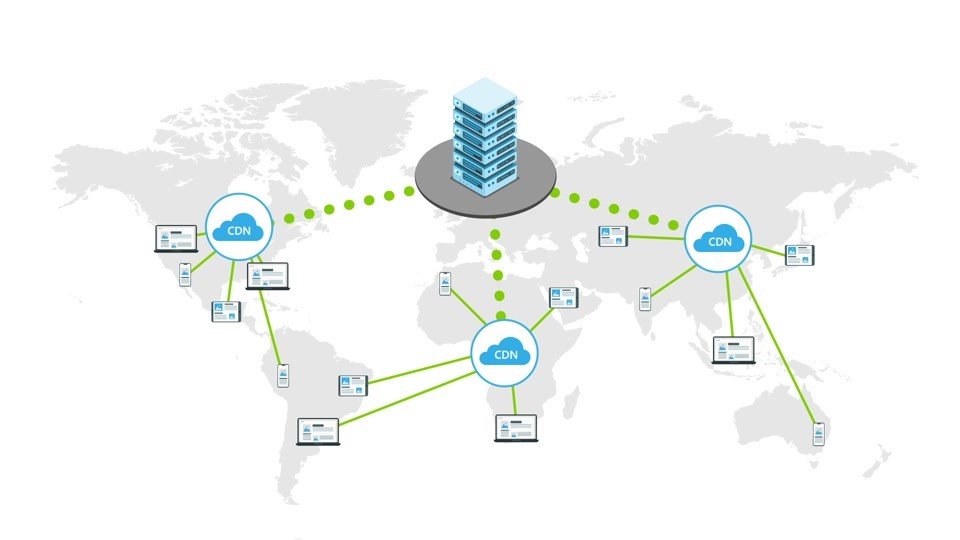In today’s digital landscape, websites and applications face unpredictable traffic patterns and increasing user demands. Handling traffic spikes effectively and scaling resources to meet these demands are crucial for maintaining performance and user satisfaction. Content Delivery Networks (CDNs) offer a powerful solution to these challenges by distributing content efficiently across a network of servers. This article explores how leveraging CDN solutions can help manage traffic spikes and improve scalability.
2. What is a CDN and How Does It Work?
A Content Delivery Network (CDN) is a distributed network of servers designed to deliver content to users based on their geographic location. By caching content at multiple edge locations around the world, CDNs reduce the distance between users and the content they request. This results in faster load times, reduced latency, and improved performance. When a user requests content, the CDN directs the request to the nearest server, optimizing the delivery process and minimizing the load on the origin server.
3. Handling Traffic Spikes with CDN Solutions
Traffic spikes can occur due to various reasons, such as promotional campaigns, viral content, or sudden surges in user activity. Without adequate infrastructure, these spikes can overwhelm your server and degrade performance. CDNs help mitigate this issue by:
- Load Distribution: CDNs distribute incoming traffic across multiple servers, preventing any single server from becoming a bottleneck.
- Caching: By caching static content (such as images, videos, and web pages) at edge servers, CDNs reduce the need to fetch content from the origin server, which can be critical during high-traffic periods.
- Dynamic Scaling: Many CDN providers offer features that automatically scale resources to handle sudden increases in traffic, ensuring consistent performance during peak times.
4. Enhancing Scalability Through CDN Solutions
Scalability refers to the ability of a system to handle increasing loads without compromising performance. CDNs enhance scalability by:
- Geographic Distribution: CDNs have a global network of servers that allows content to be served from locations closer to users, reducing latency and improving load times.
- Automatic Traffic Management: CDNs can dynamically allocate resources based on real-time traffic conditions, ensuring that the infrastructure adapts to changing demands.
- Reduced Server Load: By offloading traffic from the origin server to CDN edge servers, the load on your primary infrastructure is significantly reduced, allowing it to handle more concurrent users and requests.
5. Implementing a CDN Solution: Key Considerations
When choosing a CDN solution, consider the following factors to ensure it meets your scalability and traffic management needs:
- Coverage and Reach: Evaluate the CDN provider’s network coverage and ensure it has a sufficient number of edge locations to serve your global audience effectively.
- Performance Metrics: Look for performance benchmarks and reviews to assess the CDN’s impact on load times and latency.
- Integration and Compatibility: Ensure the CDN integrates seamlessly with your existing infrastructure and content management systems.
- Cost and Pricing Models: Compare pricing models and ensure the CDN solution fits within your budget while providing the necessary features and scalability.
6. Case Studies: Successful CDN Implementations
Examining case studies of organizations that have successfully implemented CDN solutions can provide valuable insights. For example:
- E-Commerce Sites: Many e-commerce platforms use CDNs to handle traffic spikes during sales events and promotions, ensuring a smooth shopping experience for users despite high volumes of concurrent visitors.
- Media Companies: Streaming services and media companies leverage CDNs to deliver high-quality video content to a global audience, managing bandwidth efficiently and reducing buffering.
These examples highlight how CDNs can effectively manage traffic and enhance scalability in various industries.
7. Common Challenges and How to Overcome Them
While CDNs offer numerous benefits, they also come with challenges:
- Configuration Complexity: Setting up and configuring CDN services can be complex. To overcome this, work with experienced providers and leverage their support resources.
- Content Invalidation: Ensuring that cached content is updated promptly can be challenging. Implement proper cache control mechanisms and regularly review content expiration settings.
- Cost Management: CDN costs can grow with increased traffic. Monitor usage and optimize caching strategies to manage expenses effectively.
8. Future Trends in CDN Technology
CDN technology continues to evolve, with several emerging trends:
- Edge Computing: Combining CDN with edge computing allows for processing data closer to users, further reducing latency and enhancing performance.
- AI and Machine Learning: Advanced analytics and AI can optimize content delivery and predict traffic patterns, improving the efficiency of CDN solutions.
- Enhanced Security: CDN providers are increasingly integrating advanced security features to protect against threats such as DDoS attacks and data breaches.
9. Measuring the Impact of CDN Solutions
To evaluate the effectiveness of your CDN implementation, monitor key performance indicators such as:
- Load Times: Measure improvements in page load times and user experience.
- Traffic Handling: Analyze how well the CDN manages traffic spikes and reduces server load.
- Cost Efficiency: Review the cost-effectiveness of the CDN solution compared to its performance benefits.
Regularly assess these metrics to ensure your CDN solution continues to meet your needs and delivers the expected benefits.
10. Conclusion: Achieving Optimal Performance with CDN Solutions
Leveraging CDN solutions is a crucial strategy for managing traffic spikes and improving scalability in modern web applications. By distributing content efficiently and enhancing infrastructure resilience, CDNs help maintain optimal performance and user satisfaction. By carefully selecting and implementing a CDN solution, organizations can effectively handle increasing traffic demands and ensure a seamless experience for their users


